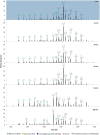Salmonella Typhimurium Enzymatically Landscapes the Host Intestinal Epithelial Cell (IEC) Surface Glycome to Increase Invasion
- PMID: 27754876
- PMCID: PMC5141278
- DOI: 10.1074/mcp.M116.063206
Salmonella Typhimurium Enzymatically Landscapes the Host Intestinal Epithelial Cell (IEC) Surface Glycome to Increase Invasion
Abstract
Although gut host-pathogen interactions are glycan-mediated processes, few details are known about the participating structures. Here we employ high-resolution mass spectrometric profiling to comprehensively identify and quantitatively measure the exact modifications of native intestinal epithelial cell surface N-glycans induced by S. typhimurium infection. Sixty minutes postinfection, select sialylated structures showed decreases in terms of total number and abundances. To assess the effect of cell surface mannosylation, we selectively rerouted glycan expression on the host using the alpha-mannosidase inhibitor, kifunensine, toward overexpression of high mannose. Under these conditions, internalization of S. typhimurium significantly increased, demonstrating that bacteria show preference for particular structures. Finally, we developed a novel assay to measure membrane glycoprotein turnover rates, which revealed that glycan modifications occur by bacterial enzyme activity rather than by host-derived restructuring strategies. This study is the first to provide precise structural information on how host N-glycans are altered to support S. typhimurium invasion.
© 2016 by The American Society for Biochemistry and Molecular Biology, Inc.
Figures






References
-
- Holgersson J., Gustafsson A., and Breimer M. E. (2005) Characteristics of protein-carbohydrate interactions as a basis for developing novel carbohydrate-based antirejection therapies. Immunol. Cell Biol. 83, 694–708 - PubMed
-
- Karlsson K. A. (2001) Pathogen-host protein-carbohydrate interactions as the basis of important infections. Adv. Exp. Med. Biol. 491, 431–443 - PubMed
-
- Ohtsubo K., and Marth J. D. (2006) Glycosylation in cellular mechanisms of health and disease. Cell 126, 855–867 - PubMed
-
- Dube D. H., and Bertozzi C. R. (2005) Glycans in cancer and inflammation–potential for therapeutics and diagnostics. Nat. Rev. Drug Discov. 4, 477–488 - PubMed
MeSH terms
Substances
Grants and funding
LinkOut - more resources
Full Text Sources
Other Literature Sources
Molecular Biology Databases

